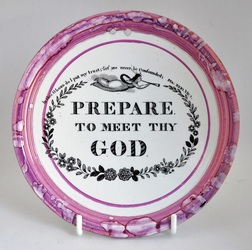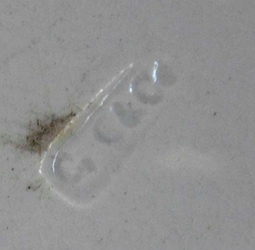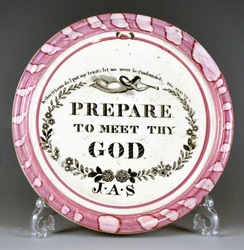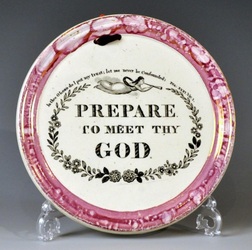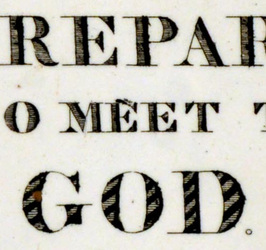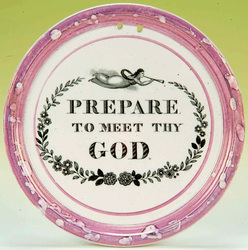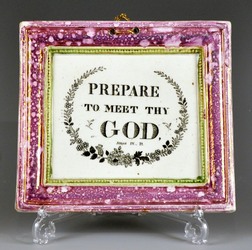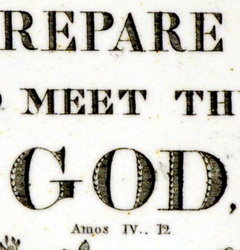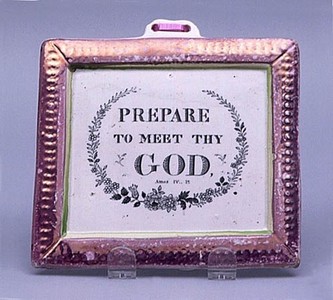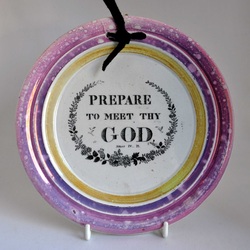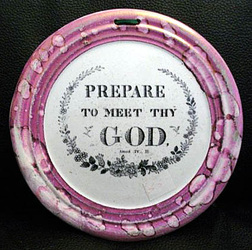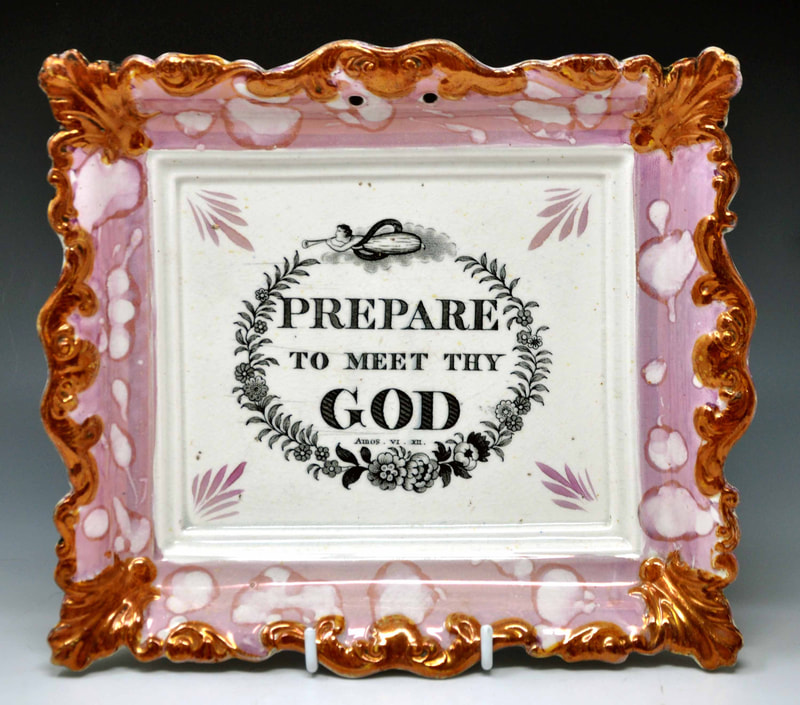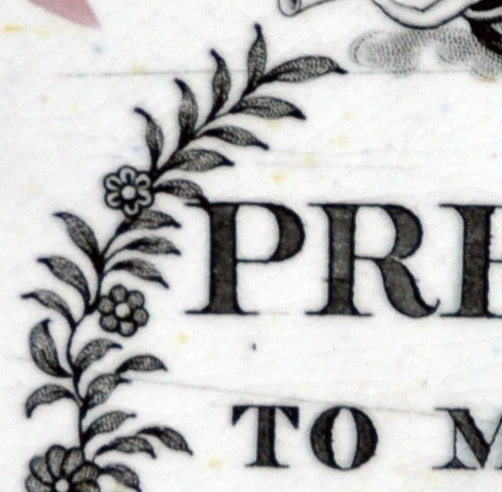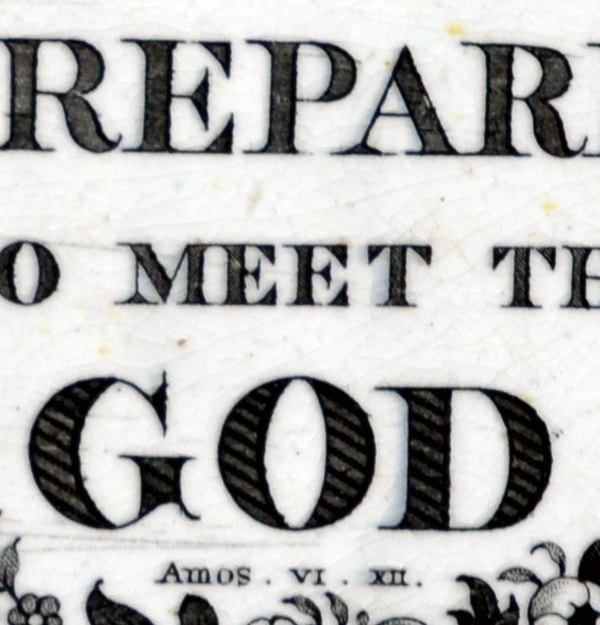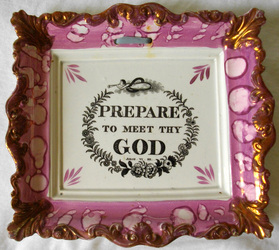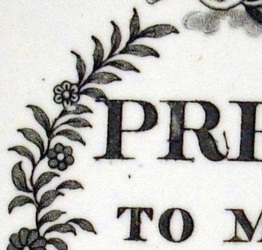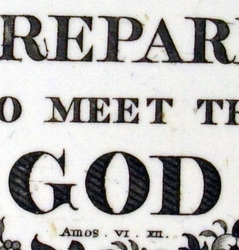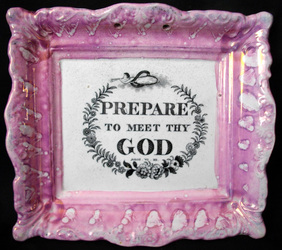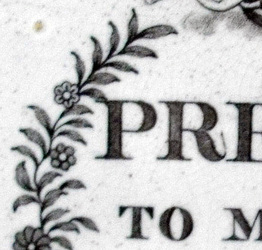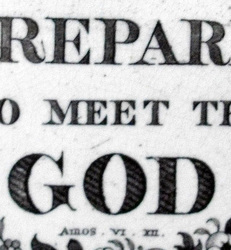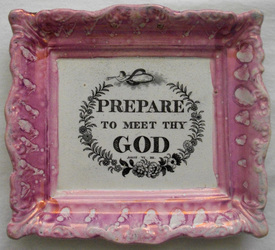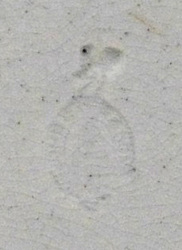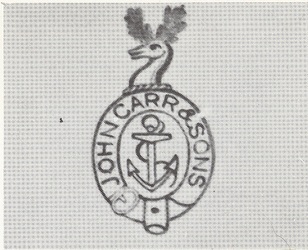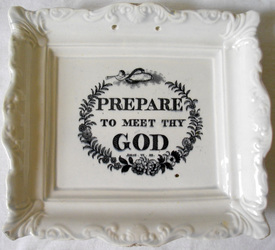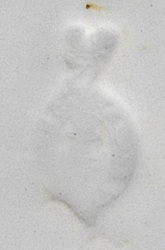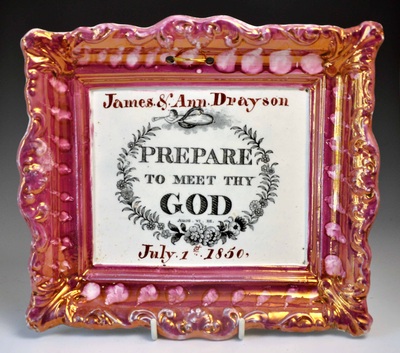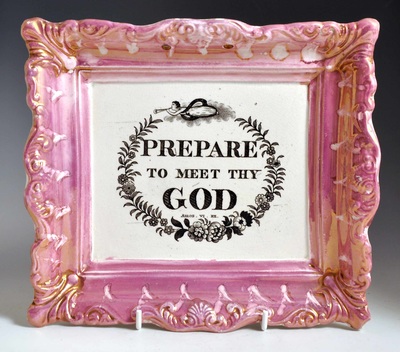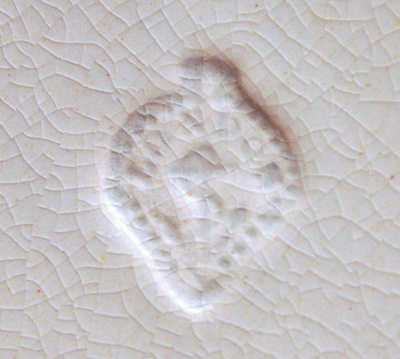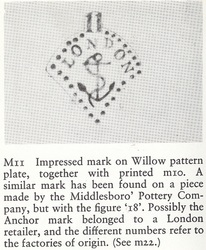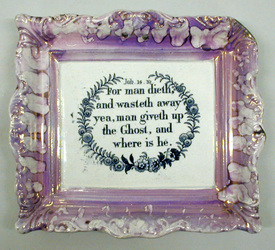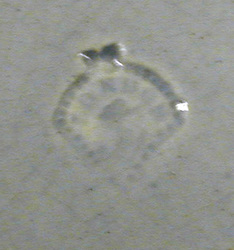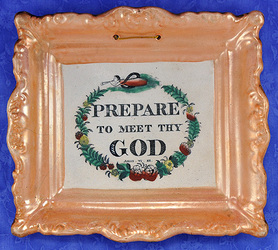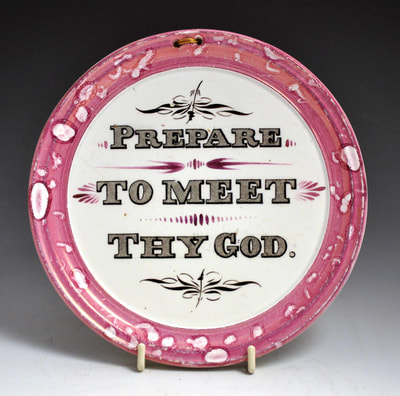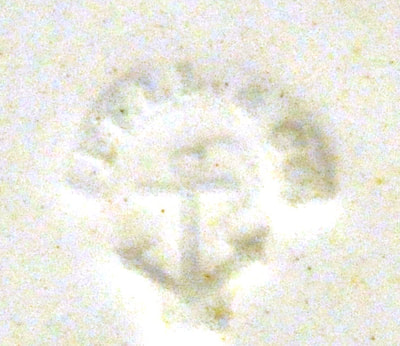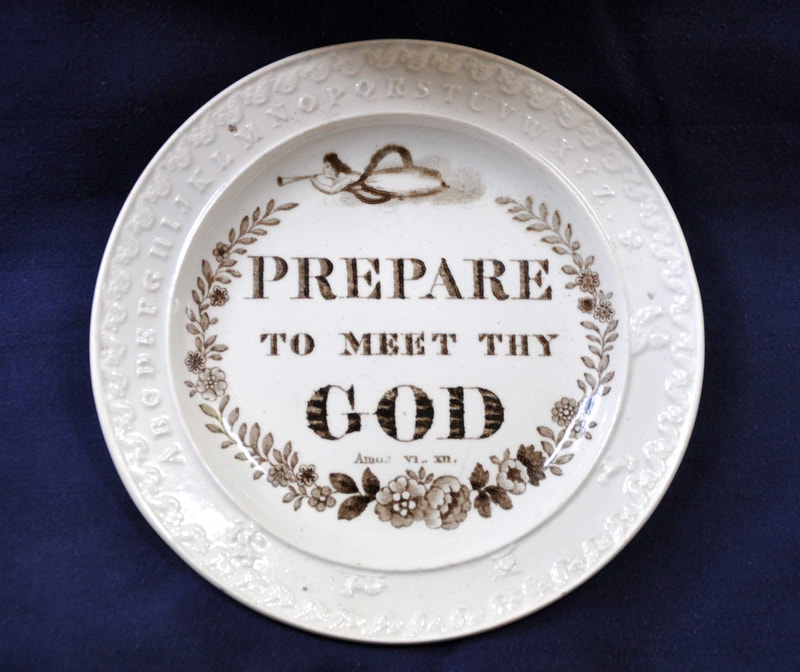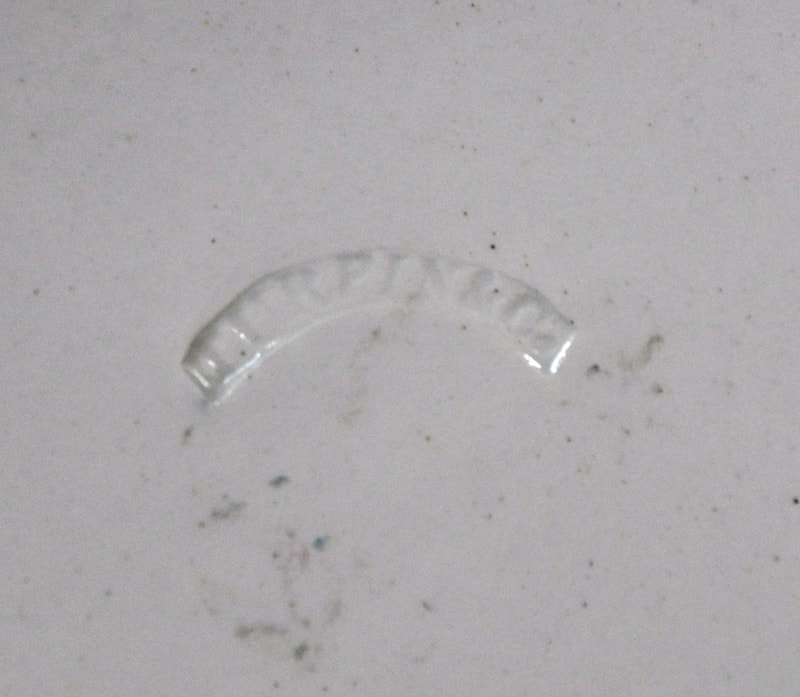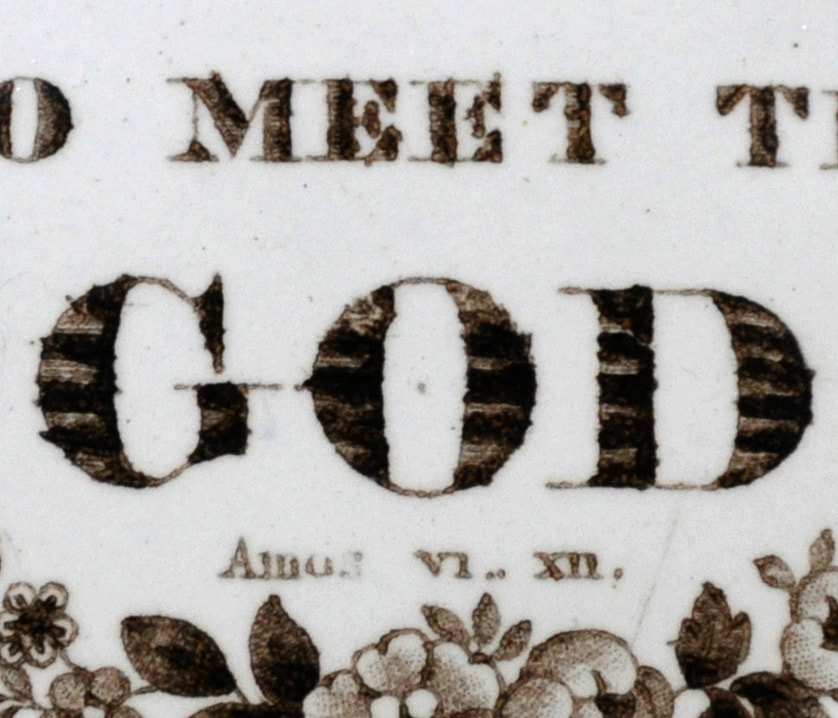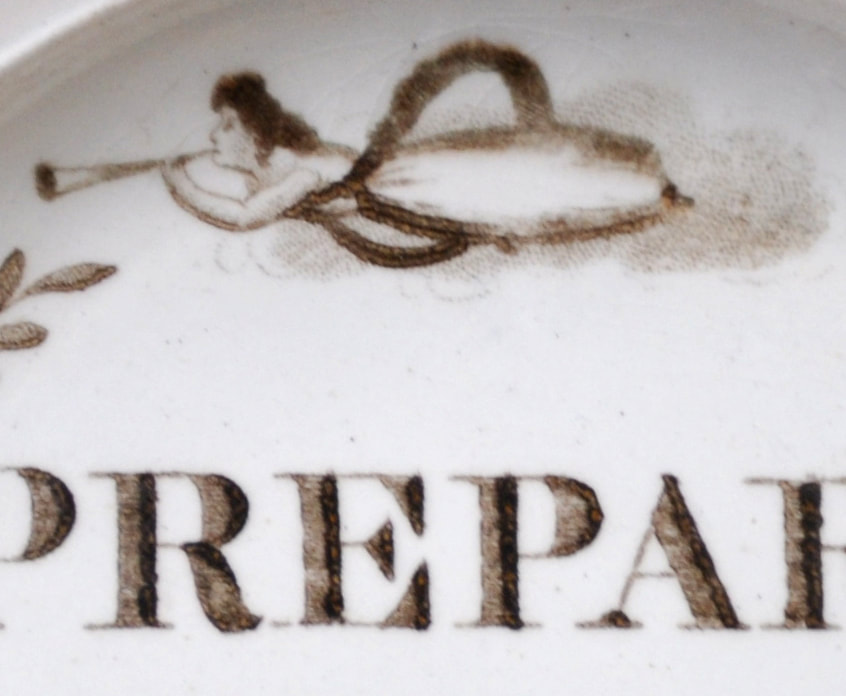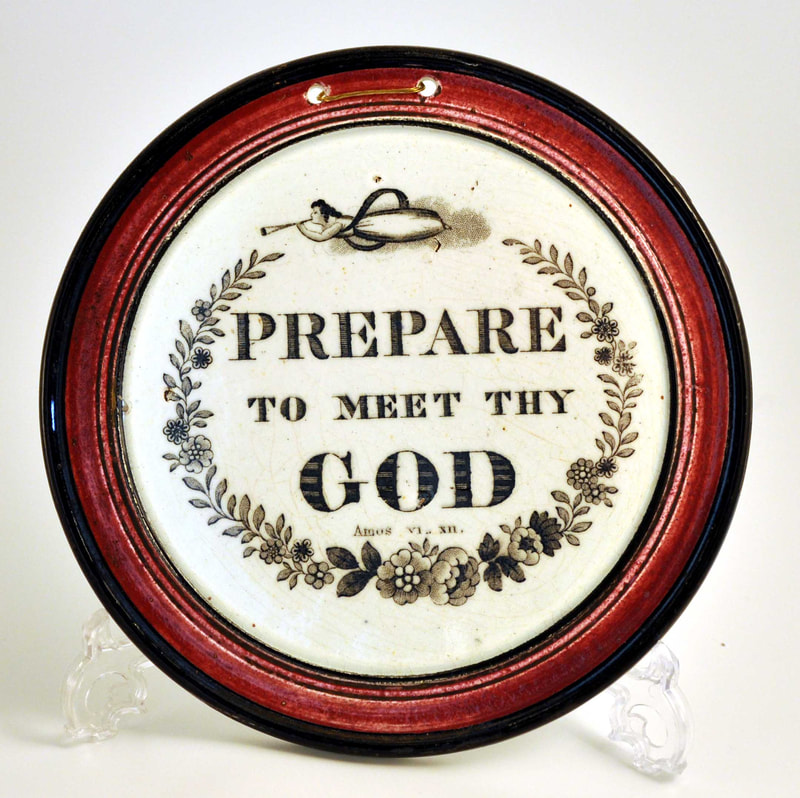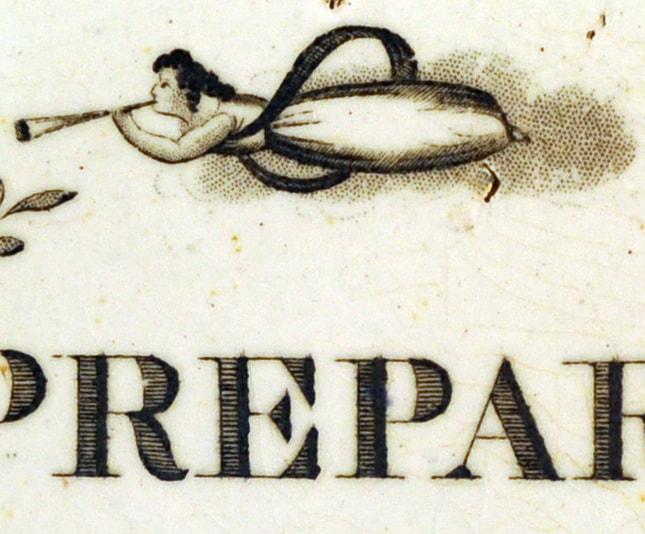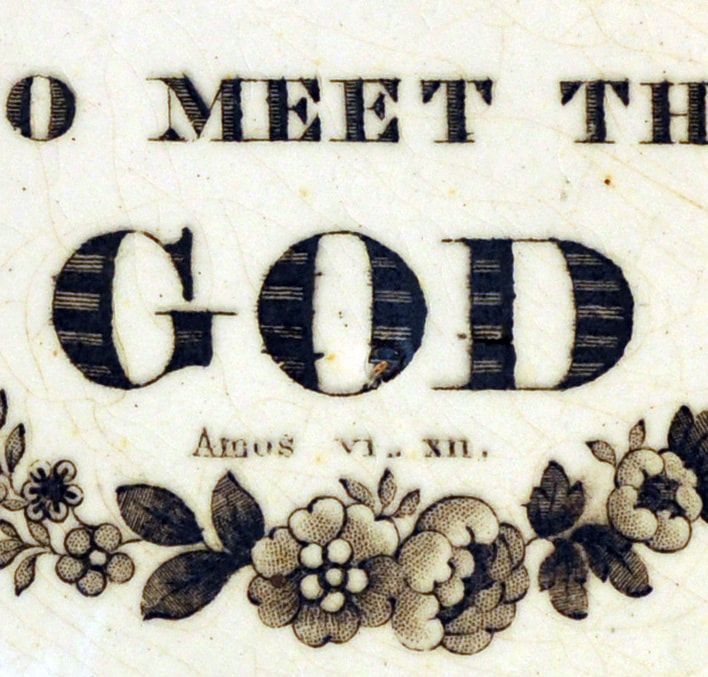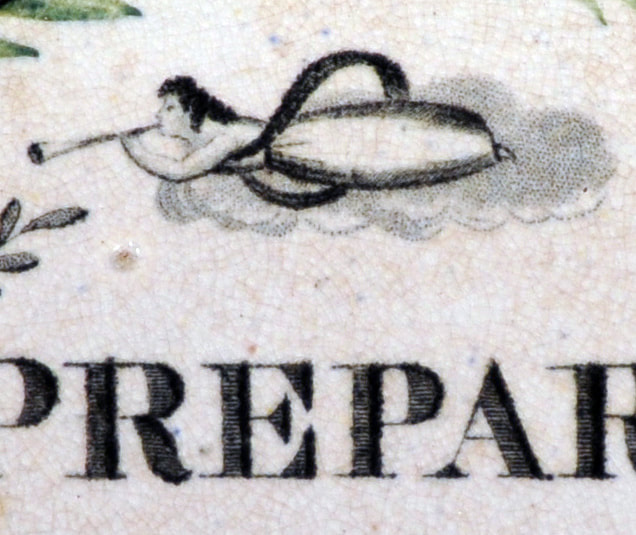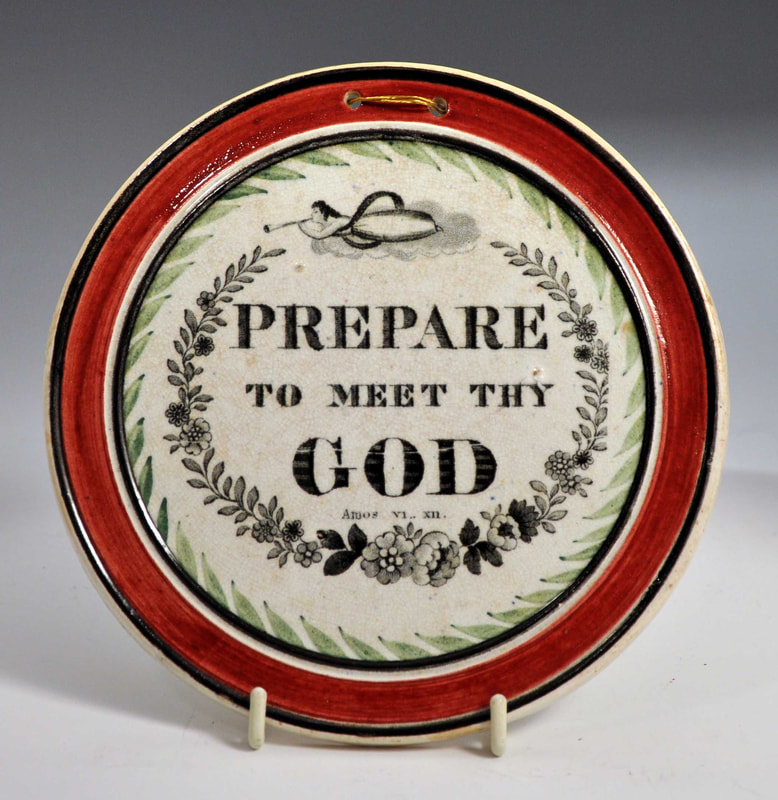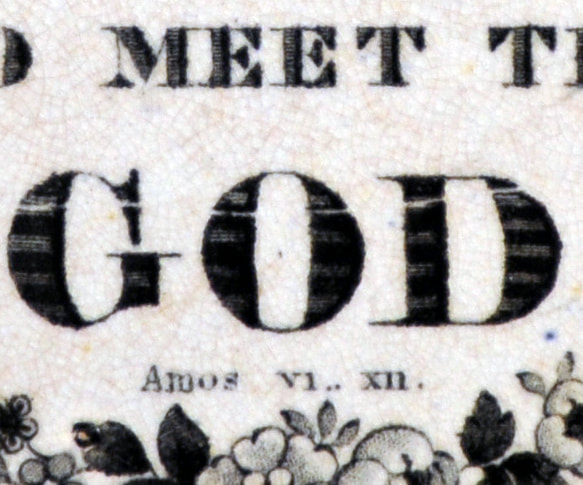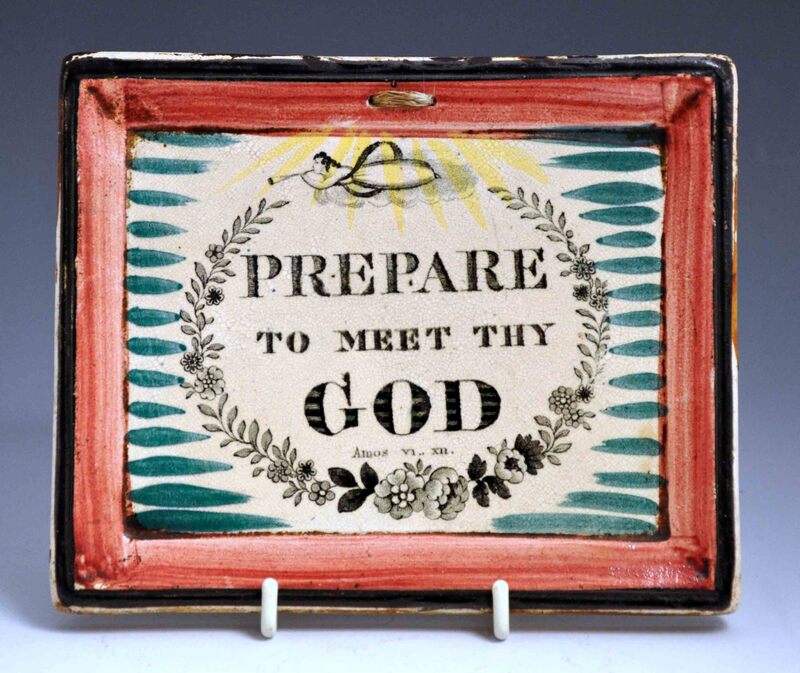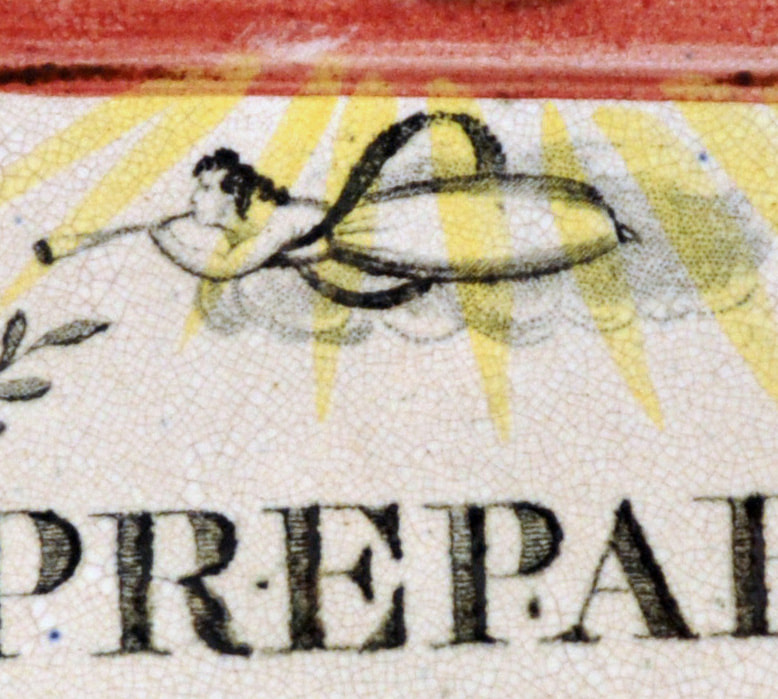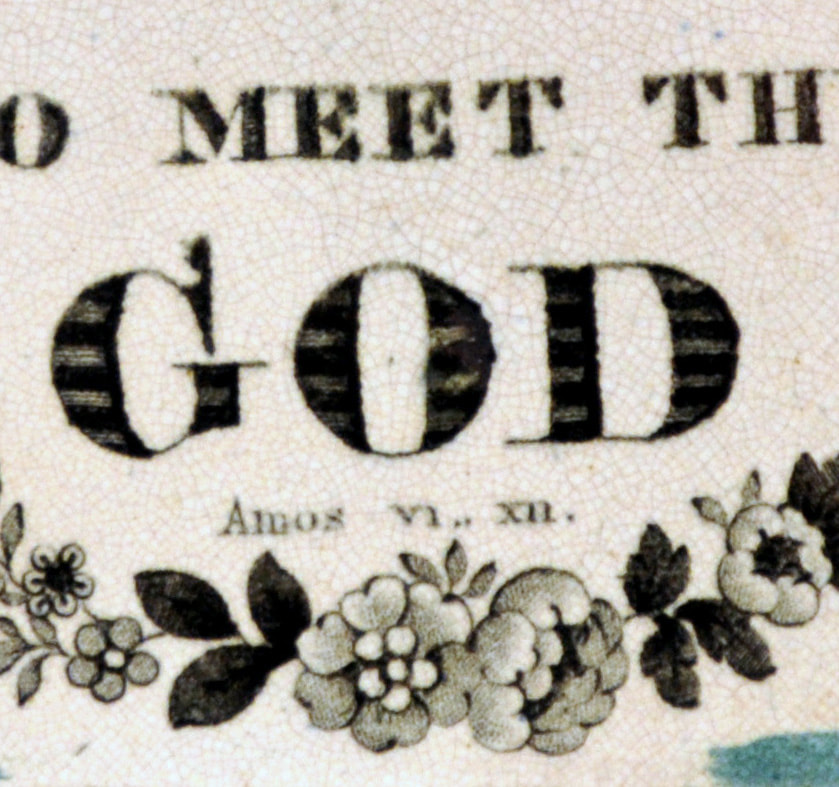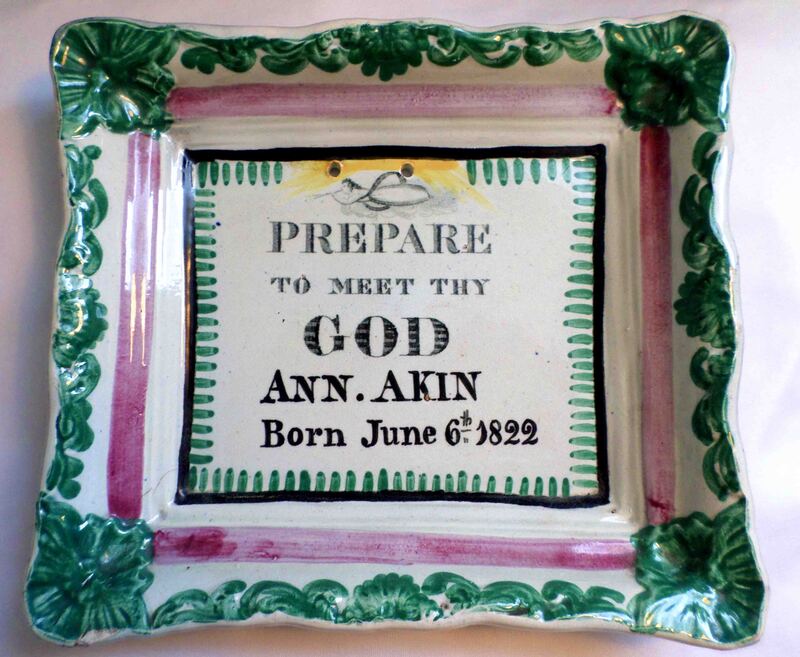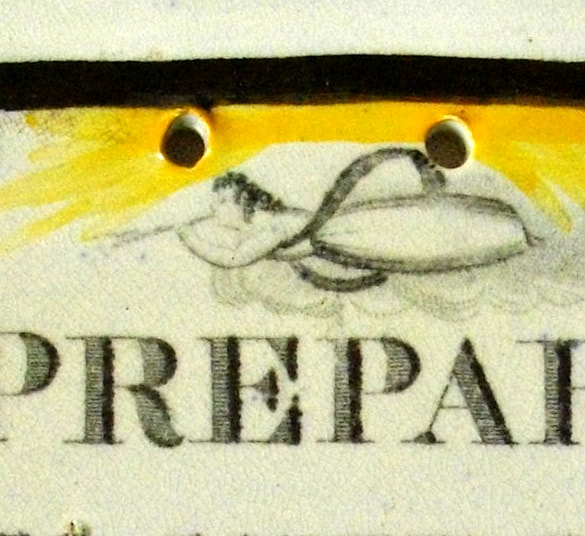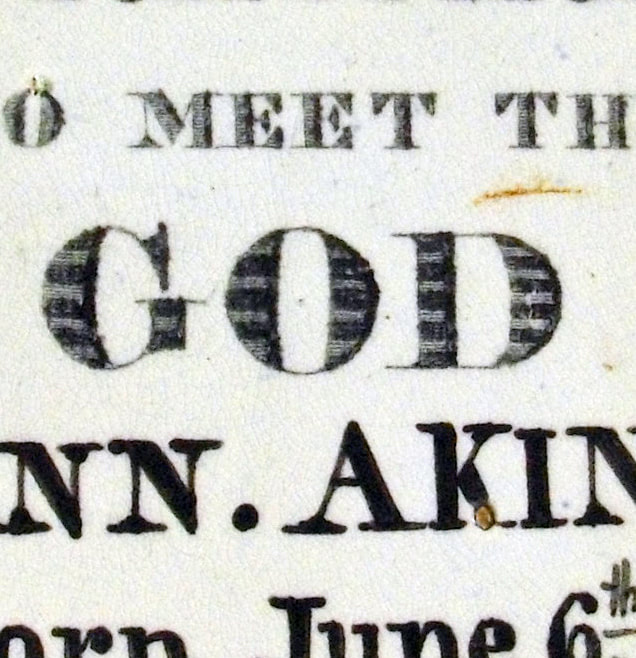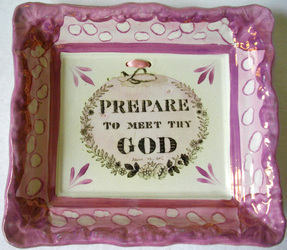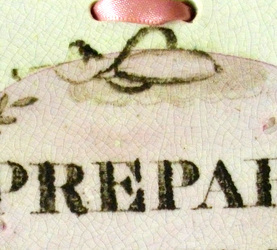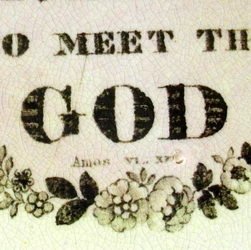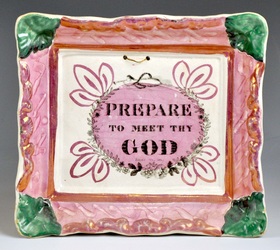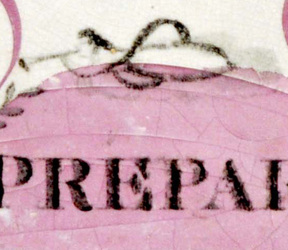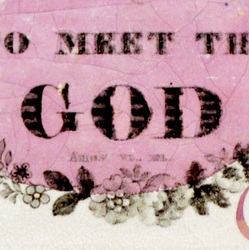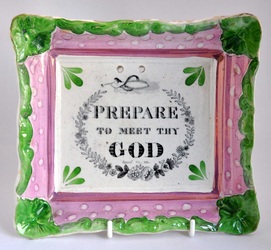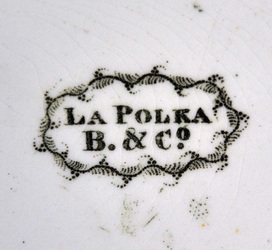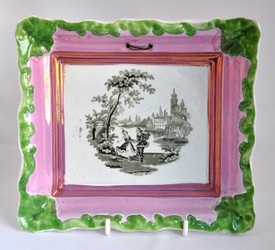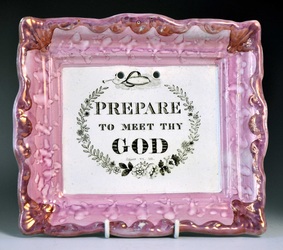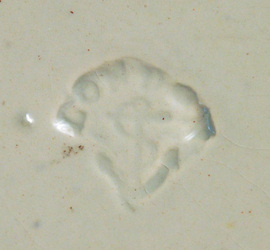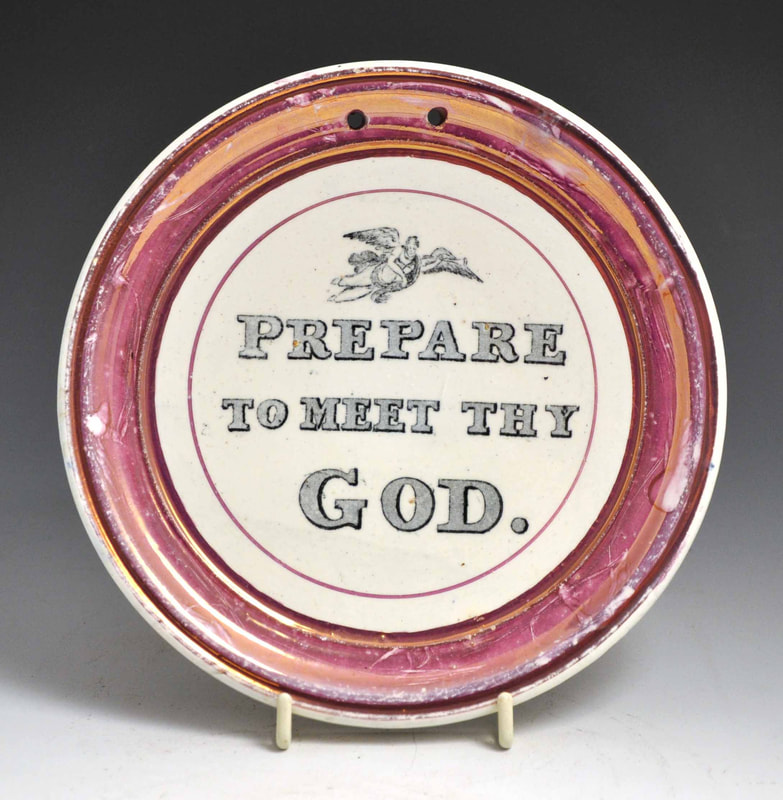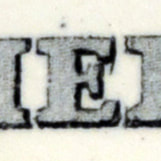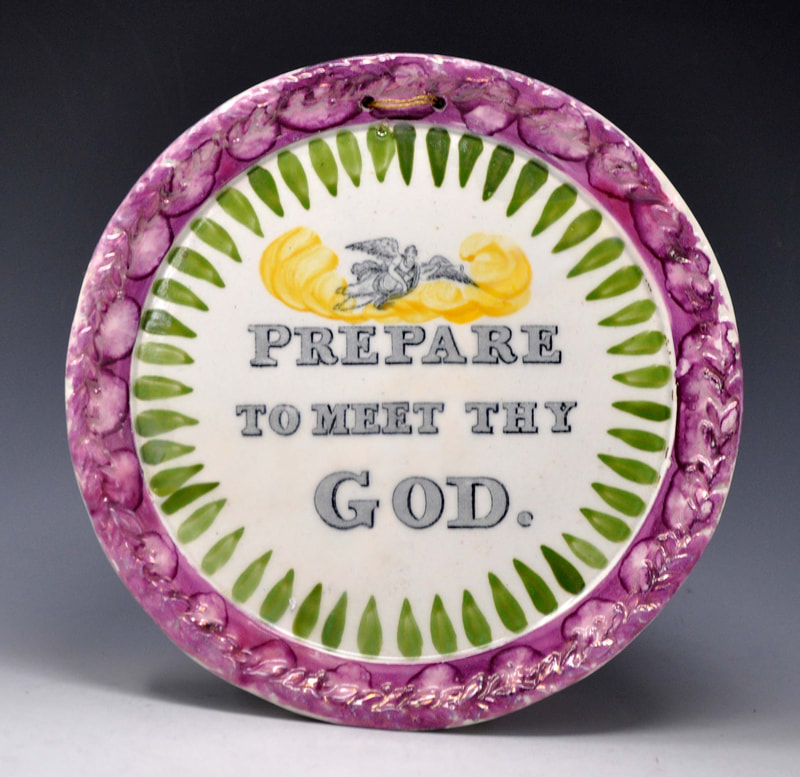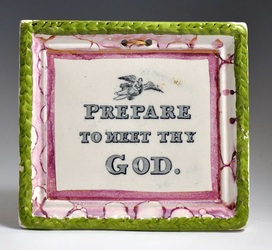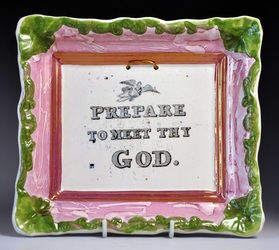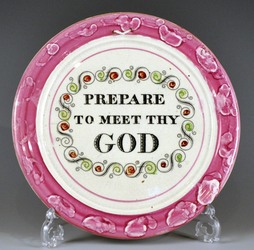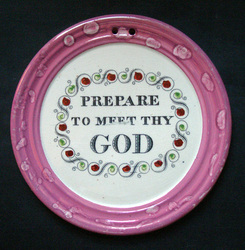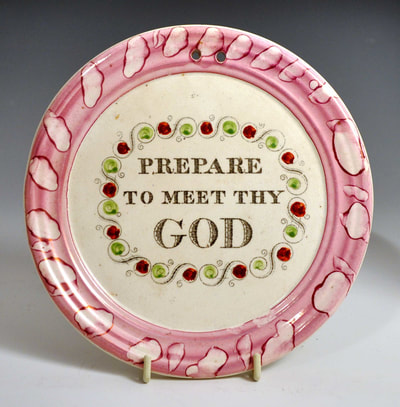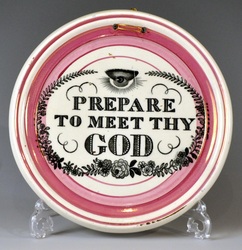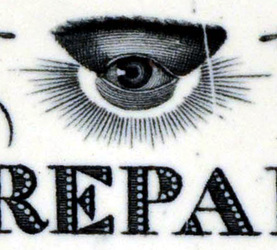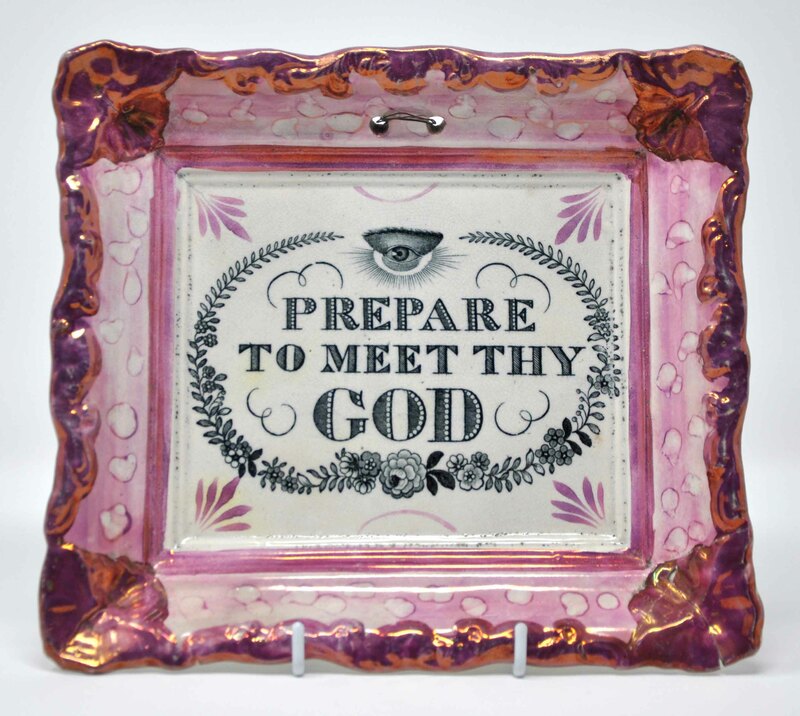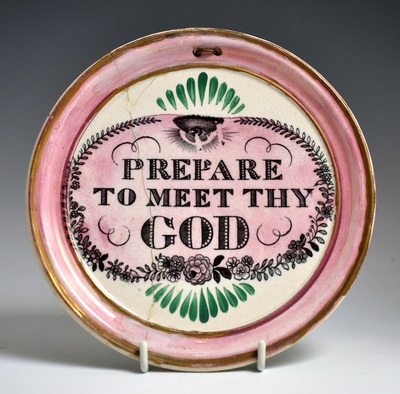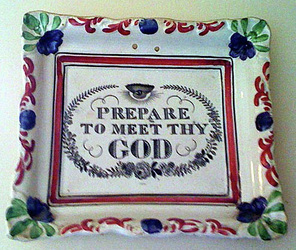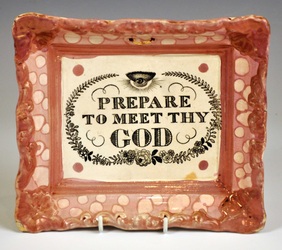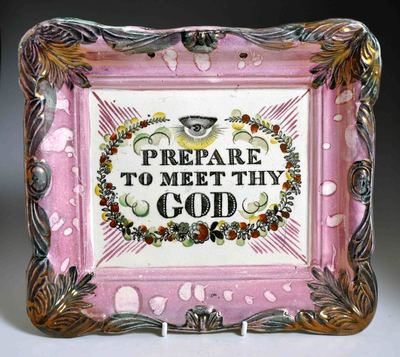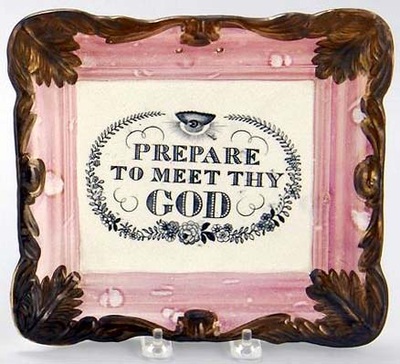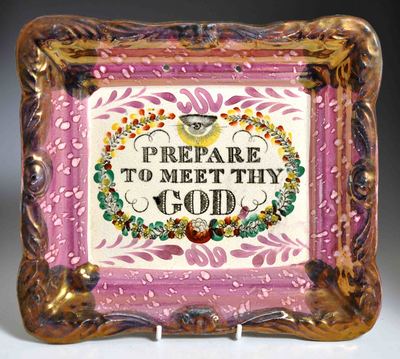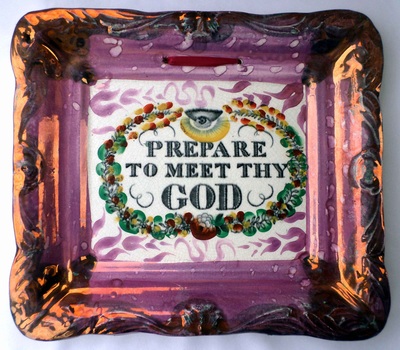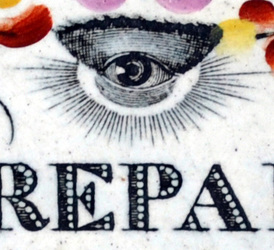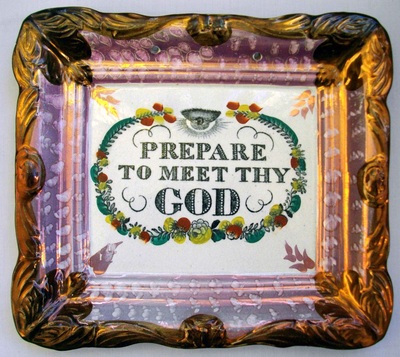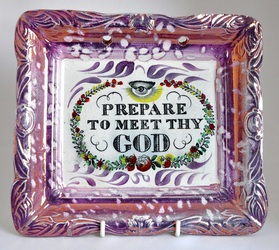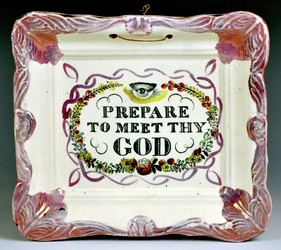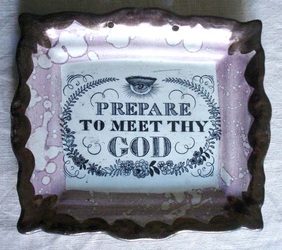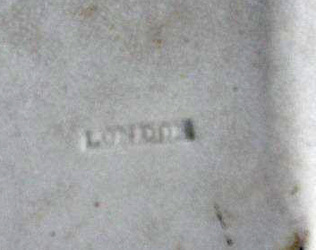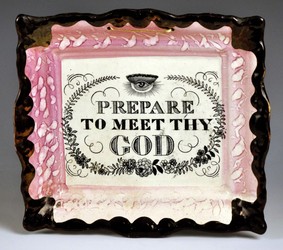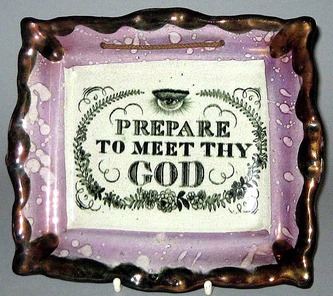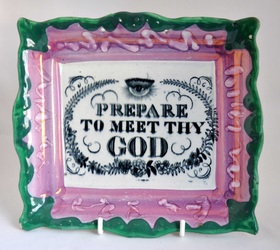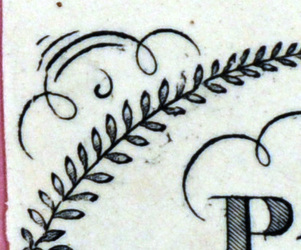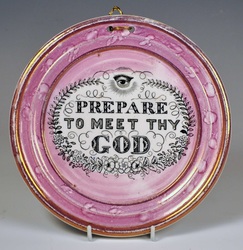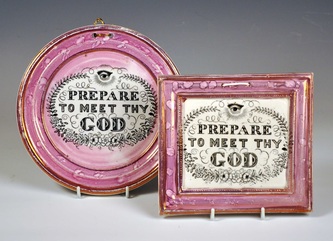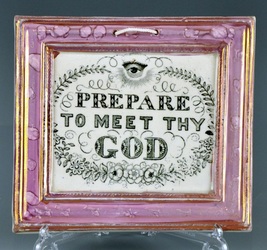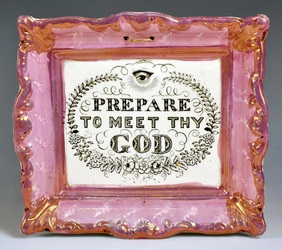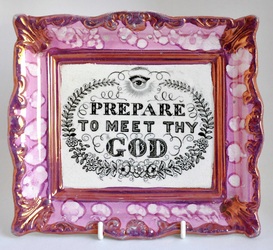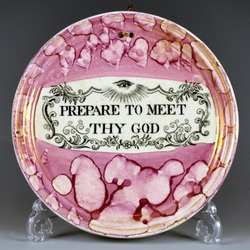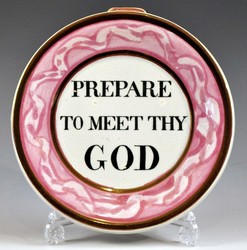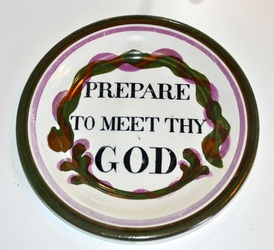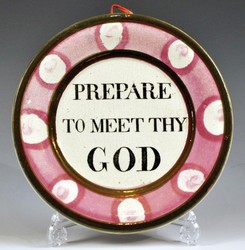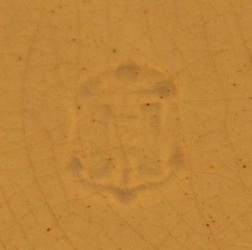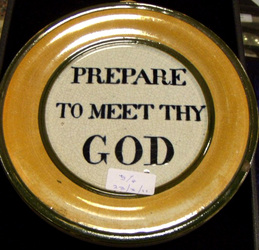Prepare to meet thy god - page 2
For an overview of pink lustre plaques with religious subjects, click on the Religious heading above. I've split the 'Prepare to meet thy god' transfers into two pages. Page 1: Wearside potteries, e.g. Scott, Moore, and Dixon. Page 2: Tyneside and other potteries, e.g. C., C. & Co, Carr, Maling, Stockton.
Cornfoot, Colville & Co, and Cornfoot, Carr & Co, North Shields Pottery
All except the top right plaque have the 'C. C&Co' impressed mark, which could have been used by either Cornfoot, Colville & Co (1829–1832) or Cornfoot, Carr & Co (1832–1838). Above the floral wreath and trumpeting angel is the verse 'In thee O Lord do I put my trust: let me never be Confounded: PSA: XXXI Vir. I.'. The words 'PREPARE TO MEET THY' are horizontally shaded. Whereas the word 'GOD', is diagonally shaded. The detail is from the plaque to its left. The plaques are 167mm diameter. The top right plaque has hand‐painted initials 'J.A.S'. The bottom right plaque has no verse above the angel. All except the top right have the 'C. C&Co' impressed mark. See other similar plaques on the C, C & Co page.
Defining features
- The word 'God' is diagonally shaded
- The angel is facing right
Attributed to the Sheriff Hill Pottery, Gateshead
None of these plaques is marked. The Wesley transfer that appears on these plaque forms, also appears on a plate with the impressed mark 'J.&P' for Jackson and Patterson of the Sheriff Hill Pottery, Gateshead, 1830–45 (R C Bell's 'Tyneside Pottery' book states the firm was run by Jackson & Patterson 1833–8, but records in the Sunderland Museum suggest 1830–45). Click here and here to read more about this attribution. Unlike the C. C. & Co and Scott plaques, the transfer includes the bible reference 'Amos IV.. 12'.
Attributed to Seaham Pottery, and John Carr, Low Lights Pottery, North Shields
Though this transfer shares similar attributes to the Dixon transfer (including the incorrectly transcribed bible reference), it is from a different transfer plate, with some easily identifiable flaws. There is a small dot just beneath the first 'P' in Prepare (click on the images to enlarge), which reproduces on all three plaques. However, at some point during the Seaham period (first two plaques) a scratch appeared extending the serif of the first letter 'R', which lurches upwards.
The first two plaques above are unmarked, but attributed to Seaham Pottery, from the 1840s. The third is from John Carr's Low Lights Pottery, North Shields, and has an impressed mark (see below). The second plaque below, also marked but without lustre, was probably a factory second. The last plaque below is unmarked and has a hand-painted inscription with the date, July 1st, 1850.
The first two plaques above are unmarked, but attributed to Seaham Pottery, from the 1840s. The third is from John Carr's Low Lights Pottery, North Shields, and has an impressed mark (see below). The second plaque below, also marked but without lustre, was probably a factory second. The last plaque below is unmarked and has a hand-painted inscription with the date, July 1st, 1850.
This transfer also appears on plaques with the London impressed mark. York Museums have a similar 'For man dieth...' plaque also with an impressed mark (bottom left and centre) that has been attributed to Middlesbrough (see Bell's comment, top right). Both John Carr and Middlesbrough are known to have used 'LONDON' impressed marks. However, the Dorman Museum in Middlesbrough has no record of Middlesbrough ever producing lustreware, so it seems more likely that both plaques below were made by Carr.
For a similar example to the orange plaque below see plate XVI, p30, Baker. Baker attributes the plaque to Ball's Deptford Pottery. However, Carr produced orange lustre wares. In view of the marked plaques above, Carr seems a more likely attribution.
Thomas Fell, St Peter's Pottery, Newcastle
Attributed to Turpin & Co, Ouseburn Pottery, and Thomas Fell & Co, Newcastle
A rare child's plate with the impress Turpin & Co. Bell's book on Tyneside Pottery identifies that partnership with Ouseburn Pottery, and says 'Mentioned in a directory of 1841'. There is a mark in the middle of the 'O' in GOD likely from where the engraver used a pair of compasses to draw it.
As with the Dixon version, the verse reference is incorrectly transcribed as ''Amos VI .. XII .". However, unlike the Dixon version, there are two full stops after the numeral 'VI ..'. The transfers are easily distinguishable from others with left-facing angels because the word 'GOD' is shaded horizontally.
The transfer was also used on plaques. Both the plate and the plaque below have the mark in the centre of the 'O'. Note, the top of the angel is slightly distorted on the plate because it has been applied to a curved surface.
The transfer was also used on plaques. Both the plate and the plaque below have the mark in the centre of the 'O'. Note, the top of the angel is slightly distorted on the plate because it has been applied to a curved surface.
Perhaps on the dissolution of the Turpin & Co partnership, the copper transfer plate moved to the nearby St Peter's Pottery of Thomas Fell in Newcastle. We know that at some point the transfer plate was re-engraved, and this seems the obvious time for someone to have done it.
Compare the clouds under the angels in the details below. The left detail is the plaque above attributed to Turpin. The right is a later plaque attributed to Fell.
Compare the clouds under the angels in the details below. The left detail is the plaque above attributed to Turpin. The right is a later plaque attributed to Fell.
The three plaques below are, therefore, attributed to Thomas Fell. They all have the mark in the centre of the letter 'O'. The green flecks and the yellow sunburst around the angel in the second and third plaques are reminiscent of Maling.
The third plaque is made from a collage of cut out bits from the transfer imprint. Note the closer proximity of the angel to the text. The wreath and verse reference have also been snipped off. The hand-painted date, 1822, is too early for this plaque form. The plaque was likely made much later, e.g. for a 21st birthday present, in 1843.
The third plaque is made from a collage of cut out bits from the transfer imprint. Note the closer proximity of the angel to the text. The wreath and verse reference have also been snipped off. The hand-painted date, 1822, is too early for this plaque form. The plaque was likely made much later, e.g. for a 21st birthday present, in 1843.
The moulds of the third plaque above and those below are similar to those used by Maling. However, the 'Thou god' pair to this transfer appears on items with the Fell crown impress (see the Thou god seest me page). Also, unlike Maling, the hanging holes are pierced through the central rectangle of the plaque, rather than through the lustre border. This appears to be a feature peculiar to Fell.
The plaque below has identical decoration to a pictorial plaque, titled 'La Polka' (right above), with the printed mark 'B. & Co.', for the Tyneside company J Burn & Co from the Stepney Bank Pottery. Its hanging holes, however, are pierced through the central rectangle of the plaque, rather than through the lustre border. B & Co emulated Fell and even copied their printed mark (see this blog post). So they may have copied Fell's green decoration, or it's possible that Burn supplied Fell with printed earthenware plaques for lustre decoration.
The transfer appears rarely on plaques with the London impressed mark (see below), known to have be used by Fell.
The plaques below are unmarked, but attributed to Fell. There is a scratch under the top right of the second letter 'E' in 'MEET', where the engraver slipped. The last plaque has a similar green border to some of the plaques above, and the hanging holes are pierced below the lustre border. The transfer is a rare variation of one used extensively by the Garrison Pottery in the 1830s. The green flecks of enamel on the second plaque are more usually associated with Maling.
The nursery plate below also has the same scratch and a flower impress I hadn't recorded previously. Robert Maling is known to have used similar marks.
Attributed to Maling, Newcastle
Attributed to John Carr, Low Lights Pottery, North Shields
The five plaques above come from the same transfer plate as the large plaques attributed to John Carr & Sons below. The circular plaques were likely made in the 1830s under the partnership of Cornfoot, Carr & Co, 1832–38. The rectangular plaques above were perhaps made slightly after that, under Carr & Patton, 1838-46. Click here to read more about the dates of the North Shields Pottery partnerships.
The above plaques are attributed to John Carr's Low Lights Pottery, North Shields, and were made c1860s. The transfer is very similar to that in the section below, except the word 'Prepare' is block shaded and has rows of white pips, and the corners don't have 'twirls' (see below).
Attributed to John Carr, Low Lights Pottery, North Shields
The first plaque has a rare 'LONDON' impressed mark, known to have been used by John Carr. It was probably used on items destined for a London distributor. The plaque is certainly Tyneside (not Thames side!). Click here to read more about the London impressed mark.
The transfer is very similar to those in the section above, except that there are some added 'twirls' in each corner. The lettering is also different, e.g. the word 'Prepare' is diagonally shaded.
The transfer is very similar to those in the section above, except that there are some added 'twirls' in each corner. The lettering is also different, e.g. the word 'Prepare' is diagonally shaded.
Other plaques with the all-seeing eye
Stockton Pottery of Thomas Ainsworth
The plaque on the top right has an impressed mark of the Stockton coat of arms – an anchor and cable impaling a castle. Henrywood (Poor Man's Pictures: Part 1) identifies a similar plaque with an impressed mark as being from the Stockton Pottery of Thomas Ainsworth. The pottery was founded in the 1840s and closed in 1901. The decoration on the first plaque, which Ian Sharp has perfectly described as 'slug trails' (!), also appears on Stockton jugs etc. The orange plaque was made post 1860.
